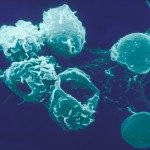Link to Pubmed [PMID] – 35924455
Link to DOI – 10.15252/embj.2021108536
EMBO J 2022; 41(19): e108536
During development, hematopoietic stem cells (HSCs) are produced from the hemogenic endothelium and will expand in a transient hematopoietic niche. Prostaglandin E2 (PGE2) is essential during vertebrate development and HSC specification, but its precise source in the embryo remains elusive. Here, we show that in the zebrafish embryo, PGE2 synthesis genes are expressed by distinct stromal cell populations, myeloid (neutrophils, macrophages), and endothelial cells of the caudal hematopoietic tissue. Ablation of myeloid cells, which produce the PGE2 precursor prostaglandin H2 (PGH2), results in loss of HSCs in the caudal hematopoietic tissue, which could be rescued by exogeneous PGE2 or PGH2 supplementation. Endothelial cells contribute by expressing the PGH2 import transporter slco2b1 and ptges3, the enzyme converting PGH2 into PGE2. Of note, differential niche cell expression of PGE2 biosynthesis enzymes is also observed in the mouse fetal liver. Taken altogether, our data suggest that the triad composed of neutrophils, macrophages, and endothelial cells sequentially and synergistically contributes to blood stem cell expansion during vertebrate development.


